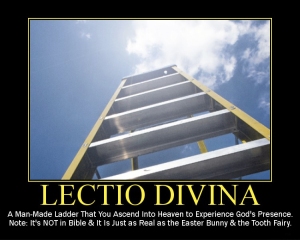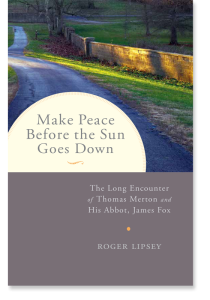(342) EMERGING TRENDS IN THE CHURCH TODAY – CONTEMPLATIVE PRAYER
In the writings of mystical Roman Catholics and so-called “Evangelicals” such as RICHARD FOSTER, DALLAS WILLARD, THOMAS MERTON, TERESA OF AVILA, THOMAS KEATING, BASIL PENNINGTON….ETC.
Today’s part 2 of Contemplative Prayer series by Marcia Montenegro. A brief background – Marcia practiced as a professional astrologer for eight years. Her formal astrological studies began in 1980 and she took classes for over two years. In 1983, she passed the 7-hour exam given by the Atlanta Board of Astrology Examiners, a Board set up by the City to formulate and grade exams to be given to aspiring astrologers wishing to practice legally in the City of Atlanta. Marcia later was a member of this Board for four years, and Chairperson for three of those years. She was also active in the Metropolitan Atlanta Astrological Society, serving as president from 1989-1990. She was also Chairperson of the Curriculum Committee, as well as working in other areas of this organization.
Before becoming an astrologer, Marcia was involved with various New Age, occult, and Eastern beliefs and practices, including Inner Light Consciousness, Tibetan Buddhism, Zen Buddhism, Hindu teachings and meditation, and psychic development classes. During these years, she also participated in past life regression, numerology, Tarot cards, spirit contact, seances, astral travel, and received a spirit guide through a guided visualization.
Today, Marcia’s ministry is CANA/Christian Answers for the New Age, and she is a missionary with Fellowship International Mission, an independent mission board based in Allentown, PA. CANA is an informational and outreach ministry.
Marcia graduated with High Honors from Florida Presbyterian College (now Eckerd College), St. Petersburg, FL, with a degree in literature. Marcia has a Masters in Religion from Southern Evangelical Seminary, Charlotte, NC.
Here is part 2 of her article word for word – I highlighted a few words for emphasis.
CONTEMPLATING CONTEMPLATIVE PRAYER: IS IT REALLY PRAYER?
By Marcia Montenegro (Parge 2 of 3)
http://christiananswersforthenewage.org/Articles_ContemplativePrayer2.html
Beyond the mind: No-thinking
According to Keating, CP should be “detachment” from thought, getting into a state of “no-thinking” and that “it is the time to let go of all thoughts, even the best of thoughts,” so that only “pure awareness” exists.17 He even claims that the Holy Spirit will not “barge in” if we are using reason and intellect, and it is “only when we are willing to abandon our very limited human modes of thought and concepts and open a welcoming space that the Spirit will begin to operate in us at this divine level . . . when we Center we practice leaving our human thoughts and reason behind and attending to the Divine, to the Spirit.”18 This presents a radical redefinition of prayer, as well as a false duality between thought or reason and spirituality, a concept common in the New Age.
Pennington discusses “a shift in consciousness” and going beyond “ordinary consciousness” into a state of “pure consciousness” in which we leave the “false self” for the “true self,” and attaining a “unity-consciousness” with God.19 He quotes “the Fathers”20 as saying that “so long as a man is aware he is praying, he is not yet praying,” and he agrees with Merton that we should “rise above thought.“21Pennington has a chapter titled “Pure Consciousness” in which he states that God “is known in pure consciousness rather than by some subject-object knowledge.”22
A writer for Youth Specialties, an organization devoted to youth ministries, states that his interest in CP began by reading Dallas Willard and Richard Foster, and later, mystics like Meister Eckhart, Teresa of Avila, and Morton Kelsey.23 He built a prayer room and reports: “In that space I lit candles, burned incense, hung rosaries, and listened to tapes of Benedictine monks. I meditated for hours on words, images, and sounds. I reached the point of being able to achieve alpha brain patterns, the state in which dreams occur, while still awake and meditating.” This sounds like going into an altered state of consciousness — a light trance state — which is the same state one enters in Eastern/New Age meditation, and which parallels techniques of self-hypnosis. In fact, the purpose of Eastern and New Age meditation is to go beyond the mind because the belief is that the mind is a barrier to spiritual enlightenment. This same writer also states that at a retreat, “We held ‘thin place’ services in reference to a belief that in prayer, the veil between us and God becomes thinner. Entire nights were devoted to guided meditations, drum circles, and “‘soul labs.'”24
Yet in the Bible, meditation on God or on the words of God is never presented as an exercise without thinking. Many of the words translated as “meditation” in the Bible are words meaning to muse, ponder, utter, or make a sound. Most of these words are in Psalms where the psalmist is praising the precepts and words of God and affirming that these are what we should learn, obey, and think upon. This is definitely not leaving ordinary thinking for another level of consciousness. Nor do we take actions to make a (non-existent) “veil” between God and us thinner. Did not the death of Jesus on the cross rip the heavy veil in the Holy of Holies of the Temple, forever serving as a symbol of how Jesus opened the way to God for those who believe?25
Due to Eastern and New Age influences in our culture, the word ‘meditation’ has come to mean a technique to enter another state of consciousness, to go inward, to go beyond thinking, or to realize spiritual enlightenment. We cannot read these techniques and purposes into the Biblical word translated as “meditation,” which originates from several different Hebrew words that do not carry the Eastern-New Age meanings. The contexts of these words indicate an active pondering, thinking and learning, not a technique nor a disengagement from the mind.
Beyond self: the false self vs. the true self
Thomas Merton claims that “the superficial ‘I’ is not our real self,” but only our “individuality” and “empirical self,” not the “hidden and mysterious person in whom we subsist before the eyes of God.”26 This kind of thinking is found also in Keating and Pennington.
Keating states that CP takes us to a place “in which the knower, the knowing, and that which is known are all one. Awareness alone remains. The one who is aware disappears along with whatever was the object of consciousness. This is what divine union is.”27
Little realizing that he was anticipating many of the teachings of CP today, one writer on mysticism asserts that the “highest state of the mystic life can only be reached when there has been a complete death of the selfhood” and when one enters the “Dark Silence, that Nothingness, that Wayless Way.”28 The author goes on to say that mystical states are “more than states of feeling, they are states of knowledge.”29 This is a gnostic view of knowledge– a secret knowledge obtained only by those able to attain these higher states.
Keating and Merton both discuss the false self and the true self. Keating capitalizes Self, and states, “God and our true Self are not separate. Though we are not God, God and our true Self are the same thing.”30 According to Merton, our “external, everyday self” is mostly a “fabrication” and is not “our true self” which “is not easy to find. It is hidden in obscurity and ‘nothingness,’ at the center, where we are in direct dependence on God.”31 Likewise, another writer asserts that the “basic idea always found in God-mysticism is that of the return of the spirit to its immortal and infinite Ground, which is God.”32 Note the word “return,” as though our spirits were originally with God, a distinctly unbiblical notion.
Buddhism teaches that our identities are merely fleeting images or impressions, like images on film, or a “sequence of happenings, of processes,”33 and that we must discover our true nature, the Buddha nature. The “conventional ‘self’ or ‘person’ is composed mainly of a history of consisting of selected memories.”34 As one Zen Buddhist says, “There is no you to say ‘I.’ What we call ‘I’ is just a swinging door which moves when we inhale and when we exhale . . . when your mind is pure and calm enough to follow this movement, there is nothing: no ‘I,’ no world, no mind nor body; just a swinging door.”35 Self is illusory in Hinduism, Taoism, and Buddhism, because the only reality is the Absolute, the Tao, or the Buddha nature.
The CP teachers do not say that we are really God, but they present a dichotomy between a false and true self. The Bible talks about the old sin nature versus the “new creature” in Christ; it is not put in terms of “true” and “false” selves, or illusion and truth, but rather in terms of bondage to sin and regeneration. It is not a matter of awareness, but rather a matter of being born again and being regenerated by the Holy Spirit. Merton does acknowledge this point in one book,36 though he still speaks of false and true selves, sometimes in Freudian psychological terms, sometimes in spiritual terms. Is our sin nature a “false self?” Not false in the sense of not being real, certainly. Such terms echo Eastern concepts, and, at the very least, are confusing and misleading.
Beyond natural: special spiritual techniques
Most of the CP teachers announce that CP is not a technique, and then they go on to recommend various techniques. Pennington offers three “rules or guides,” which include being relaxed, to be “in faith and love to God who dwells in the center of your being,” to “take up a love word,” and “whenever you become aware of anything, simply, gently return to the Lord with the use of your prayer word.”37
Merton, Keating and Pennington, and sometimes Foster, suggest repeating a word or phrase such as Jesus, Lord, Father, Friend, or the Jesus Prayer38 during CP. This can be repeated aloud or “deep within,” or used as a word to return to when one become aware of anything else. Pennington advises, “Memorize it and slowly repeat it to yourself, allowing it to interact with your inner world of concerns, memories, and ideas.”39 Keating credits the mystical Cloud of Unknowing for this idea, and states that it should be a “love word” which will take us “beyond our ordinary consciousness” as “an outreach of love to the Infinite.”40
In Hinduism, Tibetan Buddhism, Transcendental Meditation, and sometimes in New Age meditation, a word, called a mantra, is given to the meditator to repeat. This is often the name of a deity, or sometimes a phrase meaning, “I am That,” “Not this, not that,” or simply, “I am.” The purpose of this mantra is self-purification, and to become open to spiritual truths. Repeating a word or phrase over and over is also one of the tools of self-hypnosis.41 Many of the terms used by CP teachers are the same terms used in hypnosis and in Eastern/New Age teachings (i.e., “shift in consciousness, “pure consciousness,” “emptying the mind,” “creating a space,” “go beyond thought,” etc.).42
Foster quotes heavily from CP teachers and mystics. There are problematic statements such as, “Let me suggest we take an experiential attitude toward spiritual realities;” “We are working with God to determine the future! Certain things will happen in history if we pray rightly;” and, when praying for others, we should not pray “if it be Thy will” to God.43 He advocates using a visualization technique when praying in order to bring about the results.44 He also comments that “God is not a male deity as opposed to a female deity.”45
The focus on relaxation, repeating a word or phrase, concentrating on breath, detaching from thought, and trying to go beyond reasoning should cause concern. Having learned and practiced various forms of Eastern and New Age meditation for many years before becoming a Christian, I can attest to the ability to enter a light trance state using the techniques suggested by CP advocates. This state is one which New Agers and others call “pure consciousness,” where one is suspended from active thought and the ability to make judgments. In fact, Zen Buddhism teaches that one needs to cultivate the ability to detach and to set aside judgment. The mind is open and receptive, without critical thinking skills in place.46 Although Christians are indwelt by the Holy Spirit, we are not immune to deception or delusion; otherwise, the Bible would not so consistently warn believers about deception and false teachers.
Do techniques bring closeness to God, especially when such techniques are parallel to Eastern religious practices? Ephesians 2:13 tells us, “But now in Christ Jesus you who once were far off have been brought near by the blood of Christ.” We draw near to God through Christ (Heb. 4:16), not through techniques. When First John talks about abiding in Christ, it speaks of following Christ’s commandments and showing love for each other.
Beyond the west: wisdom from the east
Keating quotes from a major Buddhist text, the Diamond Sutra, to discuss “letting go,” and tells the reader that although psychic powers such as levitation may result from CP, such powers “are like the frosting on a cake and we cannot survive on frosting alone,” and so, if the reader is interested in psychic phenomena, to “be sure to practice them under an approved master.”47 Such warnings about getting attracted to psychic gifts resulting from meditation are commonly issued by those teaching Hindu and Buddhist meditation.
One author on mysticism, who also discusses many of the same techniques as used in contemplative prayer, declares: “[M]ay we not see in the mystics the forerunners of a type of consciousness, which will become more and more common as mankind ascends higher and higher up the ladder of evolution?”48 This idea is parallel to one in the New Age, which posits that as man spiritually progresses, he will gain an expanded consciousness that will include psychic or super mystical powers and insights into the nature of reality. Referring to mystics and practitioners of the medieval practice of contemplation, the author states that the contemplative has contact “with the same Reality” as the mystic, and that he “feels he has received a pure, direct vision of truth.“49 This idea is found in Eastern meditation beliefs that teach one perceives or attains truth in a more pure form through meditation techniques and in non-thinking states.
Pennington writes of his admiration for “the great Yogi, Swami Satchidanandaji” and his (Pennington’s) approval of an American professor who, “in search of true wisdom,” had gone to India to study under a Hindu Swami.50 He states that for “most Hindus, Jesus is just one of the many manifestations of the one God” but that “each person is entitled to have his or her own chosen deity or manifestation of God. Jesus is the manifestation for the West.”51 Pennington also acknowledges that both Merton and another person saw the parallels of CP with Sufi meditation and prayer,52 and he approves of Christians’ participation in Transcendental Meditation.53 He writes that CP can be learned and used effectively by anyone (i.e., non-Christians), and that he has not “hesitated” to share it with anyone.54
Another CP teacher heavily influenced by the East is Thomas Merton. Merton was a man of great intelligence, and this is apparent in his writings. But he writes of his meetings with the Dalai Lama in Asia, saying he felt a “spiritual bond” with him; he stated that he found parallels between the meditation concepts and methods of the Catholic monks with the Tibetan Buddhists, and he was even discussing establishing a Tibetan Buddhist meditation center in the U.S.55 He also called Tibetan Buddhist leader Chogyam Trungpa “wise” and a “genuine spiritual master.”56 Merton was even considering being initiated into dzogchen, an esoteric Tibetan Buddhist meditation practice, and was thinking of editing a book of Buddhist writings.57 These projects were cut short by his sudden accidental death in Asia in December, 1968, although he had written on Zen Buddhism previously.
Merton’s Asian Journals, the last words he penned, reveal his fascination with Eastern beliefs and practices. While never showing an inclination to substitute Eastern beliefs for Christianity for himself, he seemed to acknowledge Eastern religions as equally valid and showed a willingness to adapt some of their beliefs into his Christian ones. What else can one think when he writes of seeking advice on initiation into dzogchen and thinking of helping to establish a Tibetan Buddhist meditation center? Most Christians instead would be in quest of dialogue with these Buddhists in order to present Christ to them, not seeking initiation into their practices or to spread their teachings.58
 Why are professing Christians so passive during an unprecedented encroachment of evil on Christian liberty in America? There are the standard reasons. They are apathetic, weak, backslidden, hypocritical, etcetera. We could make a case for one or all of those things.
Why are professing Christians so passive during an unprecedented encroachment of evil on Christian liberty in America? There are the standard reasons. They are apathetic, weak, backslidden, hypocritical, etcetera. We could make a case for one or all of those things. The fact is, far too many professing Christians consider the diabolical intrusions as much ado about nothing. Everything goes on as before. Besides, they do not actually practice Christianity in public anyway. So where’s the loss in having something pilfered that you never bothered to use?
The fact is, far too many professing Christians consider the diabolical intrusions as much ado about nothing. Everything goes on as before. Besides, they do not actually practice Christianity in public anyway. So where’s the loss in having something pilfered that you never bothered to use?


Recent Comments